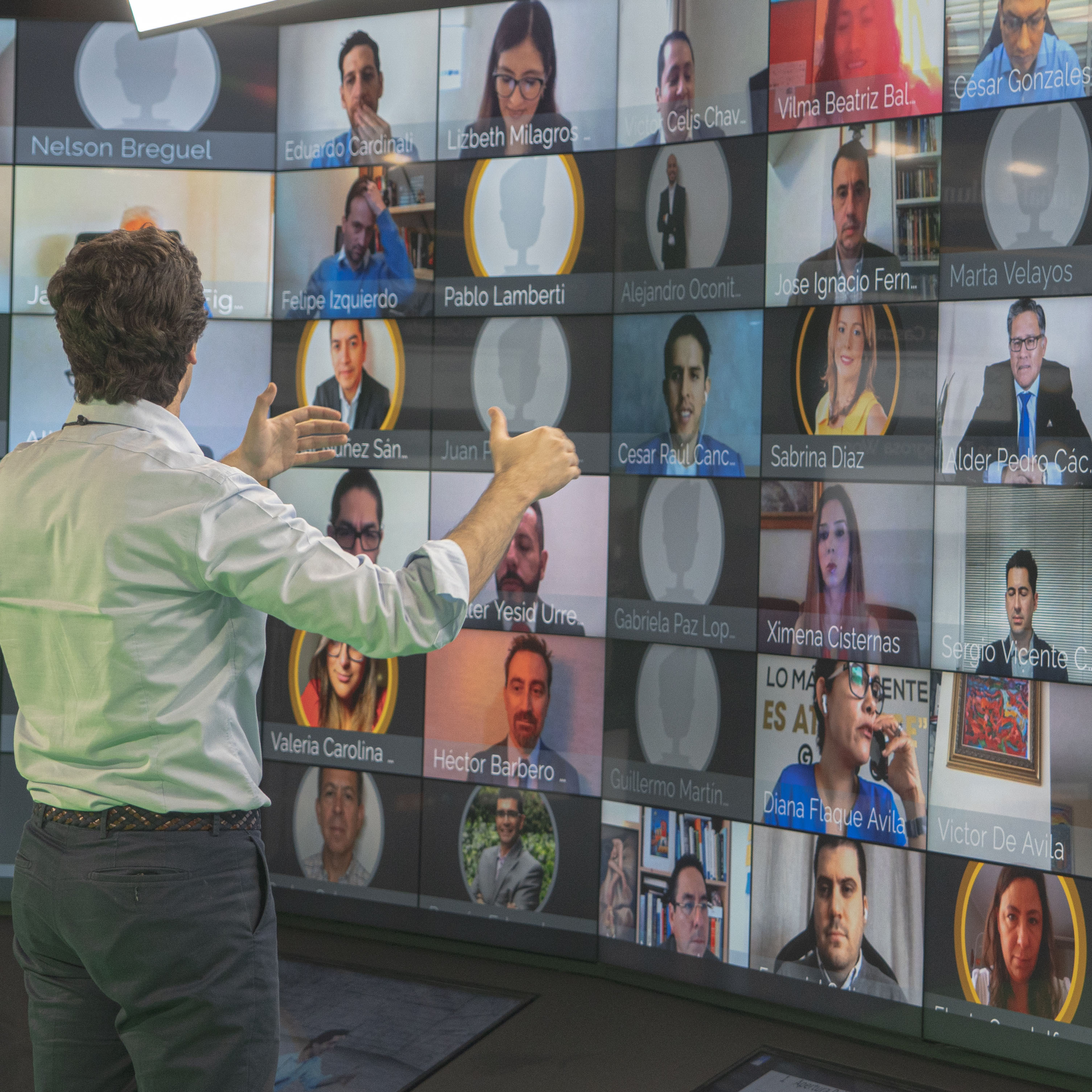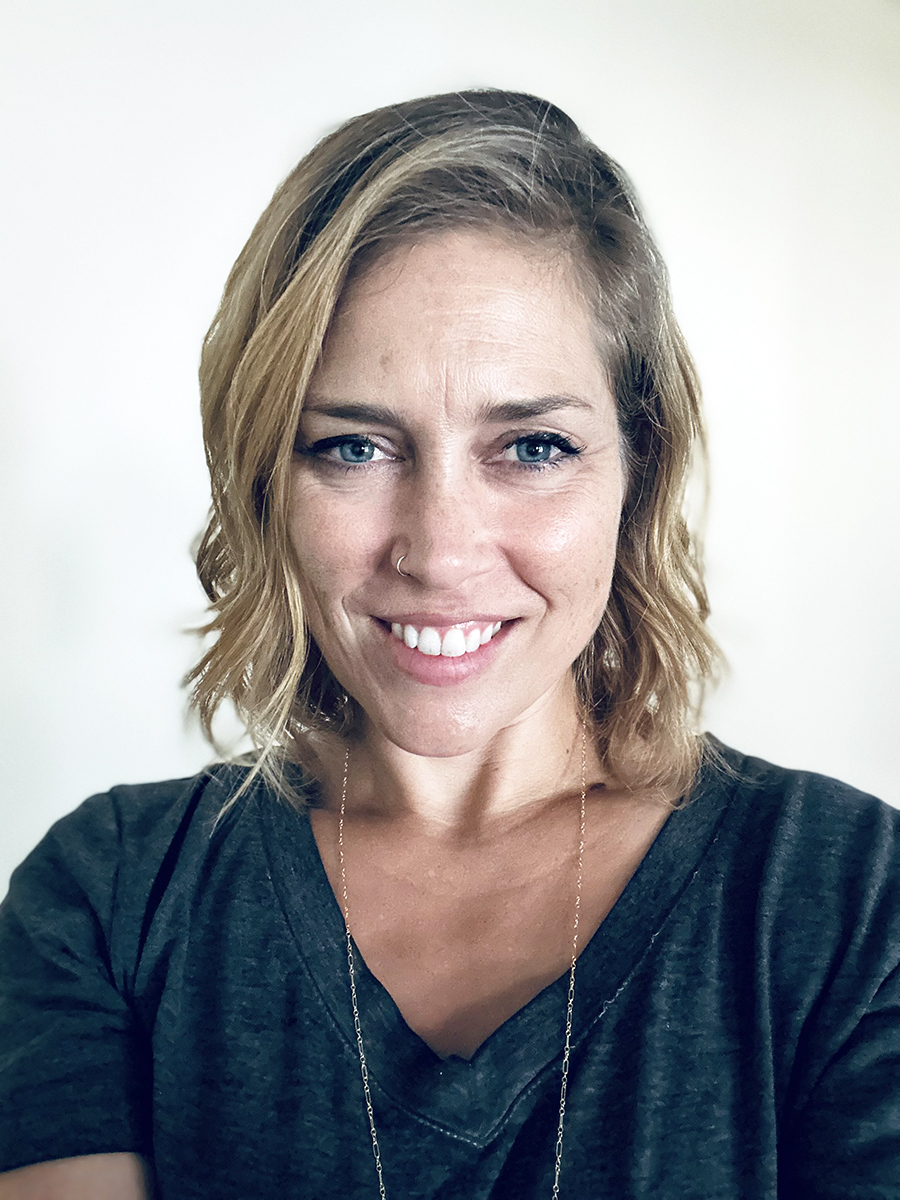“What do you think, do you like my new office?” asks André Stevens-Rosa, walking around a large studio. Behind him, a green screen projects a brick wall on which three separate images “hang.” Another camera displays Stevens-Rosa’s perspective as he speaks to a wall of screens displaying each of the meeting’s far-flung participants, larger than life.
This is the Global Bridge, a new, technologically advanced studio within the Gleacher Center where instructors conduct online class sessions for University of Chicago professional education students. The result of a partnership between the University and Madrid-based ed-tech firm Global Alumni, Global Bridge provides a more engaging, interactive experience for all students—particularly those outside the United States—that includes live surveys, 3D images, and interactive maps.
“When I was young in my teaching career, the tools we had available were overhead projectors and slide carousels, get everybody in the room together with a flip chart and write things on the board,” says Jill Ramaker, MSc ‘11, who will teach the University’s first Global Bridge course this autumn.
The project has been underway since late 2019, before the COVID-19 outbreak. “The pandemic didn’t bring something new to professional education—it just increased the pace of change,” says Marco Serrato, most recently Associate Provost. “Before the pandemic forced the world to switch to virtual learning, UChicago Professional Education wanted to invest in its capability to connect with professional audiences on a global basis.” The platform, he says, will allow teachers to more fully interact and express emotion in the virtual space and deliver a more human experience to students spread out across the globe.
The Human Touch
Given the nature and relevance of the topics covered in the course, the University made the decision to launch the new platform with Ramaker’s program on emergency management. To begin the process, Ramaker provided the Madrid team with her syllabus and class outline to update with fresh graphics and videos to be presented via both recorded and live presentations broadcast from the Gleacher Center.
Like many instructors, Ramaker has become proficient at teaching on Zoom, but hasn’t always been sure of the platform’s efficacy. “I'm confident in the classroom and I've been doing it for many years, but teaching remotely rattled some of my confidence because I didn’t want anything to go wrong with the tech,” she explains. “I didn’t know if I was really reaching the students, or they were just showing up because they had to.” She hopes that the Global Bridge will keep students more interested and engaged.
“One of the most challenging things about doing online classes is endeavoring to recover the social cues and human elements that we have organically when we’re in person, like the random hallway introduction or chatting with the instructor after class," says Matt Cohn, PhD, Director of Teaching and Learning for professional programs. “Reading other people's emotions is more challenging when you're facing a webcam. It’s really hard to understand how people are reacting when you can’t read their body language effectively.” Instruction should not feel like reading a textbook, he says. “When you think about the best teachers you've had, there’s often that very human element to that. ‘They taught me a lot and were very warm and responsive and they adapted to meet my needs as a unique individual.’ When we think about our best instructors, it goes beyond raw content, and Global Bridge helps capture that.”
A Personal Approach
When Cohn tested the Gleacher Center studio for the first time, he could immediately tell the difference between Global Bridge and other virtual meeting systems. “The fact that I could see myself and could present as a full, embodied person was much more natural than presenting in front of a tiny webcam where my face is framed in an unappealing and narrow way. It felt more like a regular person talking to regular people in that environment where I was framed as a full human being and could move around and gesture.”
According to Serrato, “Students will benefit from a more natural instructor presence, and the instructor’s teaching will in turn benefit from presenting to more engaged students. Enabling instructors to convey their humanity in their virtual teaching is important to UChicago professional education. A high academic standard needs to be complemented by demonstrating practical applications—how something works—in a person-to-person context. It’s not only about discussing machine learning for healthcare informatics or project management, but how you take this into the real world.”
“The Global Bridge gives all users, not just the instructor, more of a sense that they are physical beings,” says Eugenia Williamson, a University of Chicago writer who works with Global Alumni. “Thanks to the view that shows all the class participants on monitors in front of the instructor, there’s something more formal about the Global Bridge than standard Zoom, and it definitely felt more like being in an actual classroom,” she added.
“Ultimately, these capabilities will allow UCPE to effectively deliver the debate and dialogue integral to a UChicago education to its global students,” Serrato says. “The value in our sessions comes not just from our instructor, but among our students, who will learn through their peers and classmates’ experiences as well,”
Ramaker admits to being slightly intimidated about being among the first UCPE faculty members to facilitate her class from the Global Bridge. However, she says that if the pandemic was good for anything, it showed teachers how adaptive they are. “We all had to switch on a dime to figure out a new way to educate people,” she says. “In some ways, the pandemic gave us the opportunity to be creative with higher education and professional education. I think that’s now being rewarded.”



